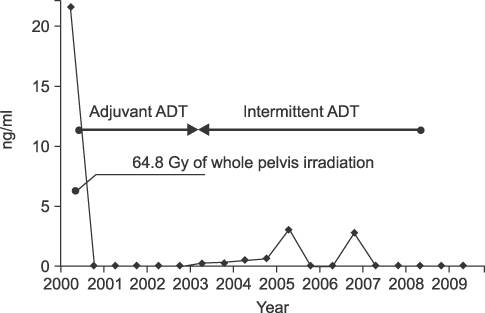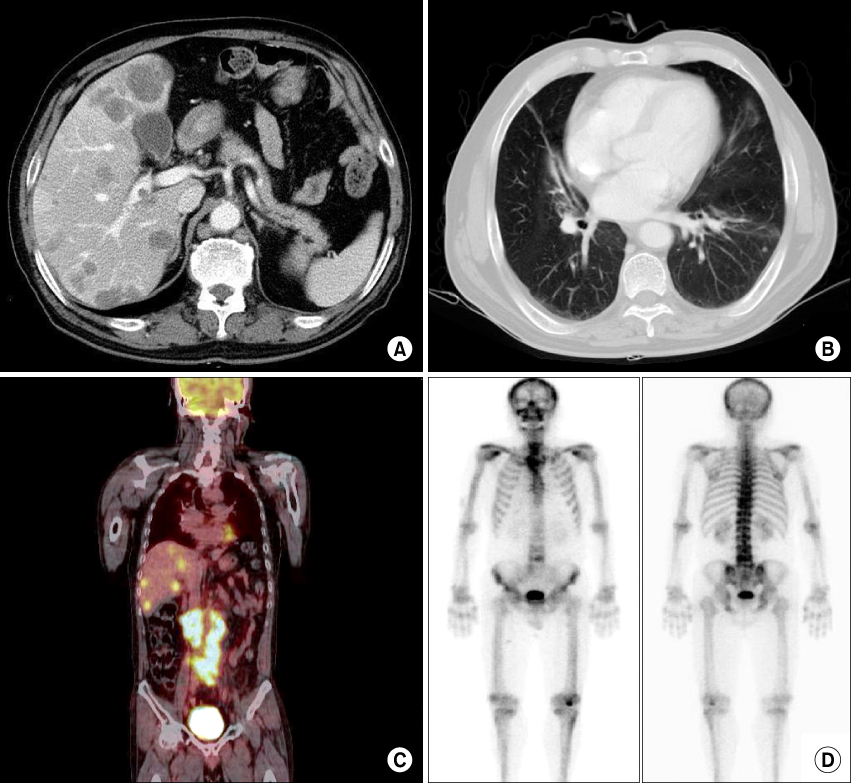Korean J Urol.
2010 May;51(5):358-361.
Progression of Prostate Cancer Despite an Extremely Low Serum Level of Prostate-Specific Antigen
- Affiliations
-
- 1Department of Urology, Korea Cancer Center Hospital, Seoul, Korea. andrea@kcch.re.kr
Abstract
- A 61-year-old man who had been diagnosed with prostate cancer 9 years ago and had been treated with pelvic irradiation and intermittent androgen deprivation therapy visited the emergency room because of back pain and weakness in both legs. Spine magnetic resonance imaging showed a lumbar epidural mass and spine metastasis. The whole-body workup revealed multiple metastases to the lymph nodes, bone, liver, and lung. The serum prostate-specific antigen was 0.02 ng/ml. He underwent laminectomy, posterior fixation, and epidural mass excision, and metastatic adenocarcinoma from the prostate was diagnosed. The patient underwent 1 cycle of docetaxel-based chemotherapy. More chemotherapy could not be done because of his general weakness. The patient died one month later of multiple organ failure.
Keyword
MeSH Terms
Figure
Reference
-
1. Shin JS, Choi HJ, Choi YS, Chai SE, Choi HY. Predictive factor for the early progression of androgen independent prostate cancer in intermittent androgen deprivation therapy. Korean J Urol. 2004. 45:858–864.2. Leibovici D, Spiess PE, Agarwal PK, Tu SM, Pettaway CA, Hitzhusen K, et al. Prostate cancer progression in the presence of undetectable or low serum prostate-specific antigen level. Cancer. 2007. 109:198–204.3. Yamamoto S, Ito T, Akiyama A, Aizawa T, Miki M, Tachibana M. M1 prostate cancer with a serum level of prostate-specific antigen less than 10 ng/mL. Int J Urol. 2001. 8:374–379.4. Namiki M, Ueno S, Kitagawa Y, Konaka H, Mizokami A, Koh E, et al. Hormonal therapy. Int J Clin Oncol. 2007. 12:427–432.5. Na KI, Yoon DK, Cho JH. The change of serum prostate specific antigen after hormonal therapy of metastatic prostatic cancer. Korean J Urol. 1996. 37:1234–1238.6. Sella A, Konichezky M, Flex D, Sulkes A, Baniel J. Low PSA metastatic androgen-independent prostate cancer. Eur Urol. 2000. 38:250–254.7. Nishio R, Furuya Y, Nagakawa O, Fuse H. Metastatic prostate cancer with normal level of serum prostate-specific antigen. Int Urol Nephrol. 2003. 35:189–192.8. Magklara A, Scorilas A, Stephan C, Kristiansen GO, Hauptmann S, Jung K, et al. Decreased concentrations of prostate-specific antigen and human glandular kallikrein 2 in malignant versus non-malignant prostatic tissue. Urology. 2000. 56:527–532.9. Oefelein MG, Smith N, Carter M, Dalton D, Schaeffer A. The incidence of prostate cancer progression with undetectable serum prostate specific antigen in a series of 394 radical prostatectomies. J Urol. 1995. 154:2128–2131.
- Full Text Links
- Actions
-
Cited
- CITED
-
- Close
- Share
- Similar articles
-
- Change of serum prostate specific antigen values after radiation therapy in prostate cancer
- The Diagnostic Value of Prostate-specific Antigen and the of Routine Laboratory Examination for Early Detection
- Prostate Specific Antigen Density (PSAD) in the Detection of the Prostate Cancer
- The Factors Influencing the Percentage of Free Serum Prostate Specific Antigen Levels in Men without Clinically Detectable Prostate Cance
- Recurrent Prostate Cancer Presenting as Multiple Lung Metastases with a Low Serum Prostate-specific Antigen Level 5 Years after Prostatectomy: A Case Report




